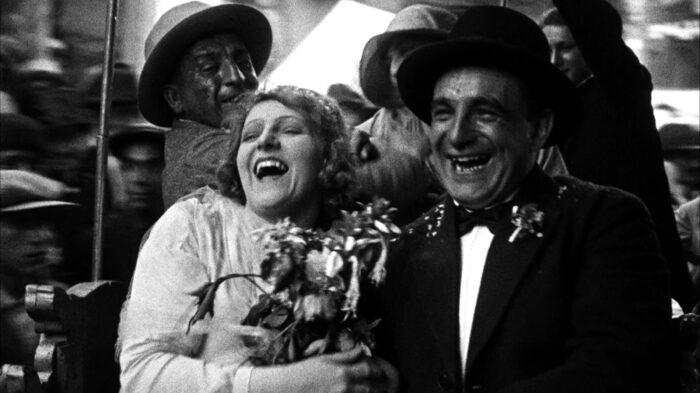The wedding festivities of a small mountain town continue long into the evening, until the newlyweds finally retreat to the peace of their home for the night. Months later, after an accident mistakenly caused by children in the mine leaves him disfigured, the husband (Charles Vanel) is forced to wear a metallic mask to conceal his hideous scars. The married couple grows estranged from one another as the wife (Sandra Milovanoff) falls for another man and begins to plan their escape. The husband catches them red-handed just as they are leaving – the lover wearing the mask, having found it hanging on the wall of the room. The husband, scarred even further by the betrayal, meets his end as a consequence of the altercation. His body is disposed of in a nearby industrial pool, but the rising sun brings new surprises…
Director Charles Vanel (1892-1989) was better known for his acting career, having played almost 200 different roles in films by directors such as Jean Grémillon, Jacques Feyder, Henri-Georges Clouzot, Luis Buñuel, and Alfred Hitchcock. Dans la nuit (Into the Night), the only full-length film he ever directed, delves (as the name suggests) into darkness and the realms of hatred, passion, shame, and regret. The half-man-half-monster and his apathetic self-pity are countered by the wife’s fumbling solidarity, with possibly (according to a more Jungian reading) even a curious hint of the lustful fervor of monster sex. The tempo is instantly hectic, like Jean Renoir’s films from the 1930’s but at double the speed, and even the wedding sequence at the beginning of the film is something like an amphetamine-powered variant of the similar eruption of happiness waiting five years on the horizon in Jean Vigo’s L’Atalante (1934).
Dramas of jealousy are the bread and butter of the French (not to diminish the Italians by any means). The broad-shouldered Vanel is like a sturdier version of Raimu, and in other aspects of the story, hints can be perceived of Marcel Pagnol’s The Baker’s Wife (1938) – but this time, the themes slip over towards horror as well.
The film could be compared to works such as Lon Chaney’s various early contributions, Paul Leni’s The Man Who Laughs (1928), based on Victor Hugo’s text and screened here in Sodankylä, Georges Franju’s later Eyes without a Face (1960), or the elder Alexandre Dumas’ literary work on the Man in the Iron Mask. In this film, however, we are far from the opulence of royal courts and deep in the bitter stench of mine dust, as Vanel tells his story, which reaches towards fundamental questions, painfully directly. The first-time director’s natural virtuosity (cf. Charles Laughton’s The Night of the Hunter, 1955) is highlighted even more by the scarcity of text panels in the film, and even the few words that appear emerge on the screen without a separate frame, like thoughts bursting forth in the night. The champagne-steeped glee of the opening sequence, through tragedy, turns into a burdensome desolation of the soul, as the wounded man defeatedly resigns himself to his bed as in a depression. From another point of view, a political one, the viewer might wonder what role the factory’s finances have played in guaranteeing the safety of their worker and in treating the trauma after the fact.
Among the film’s devoted admirers was the French director Bertrand Tavernier, who said that the film ”shows a freedom of tone to treat both dread and happiness, a richness of subject, a patience with the image itself, a requirement, a rhythm: in short, cinematographic poetry.”
The musical interpretation of the film for the festival’s Saturday concert will be provided by members CW03 and CW04 of the perennial audience favorite band Cleaning Women.
Lauri Timonen
